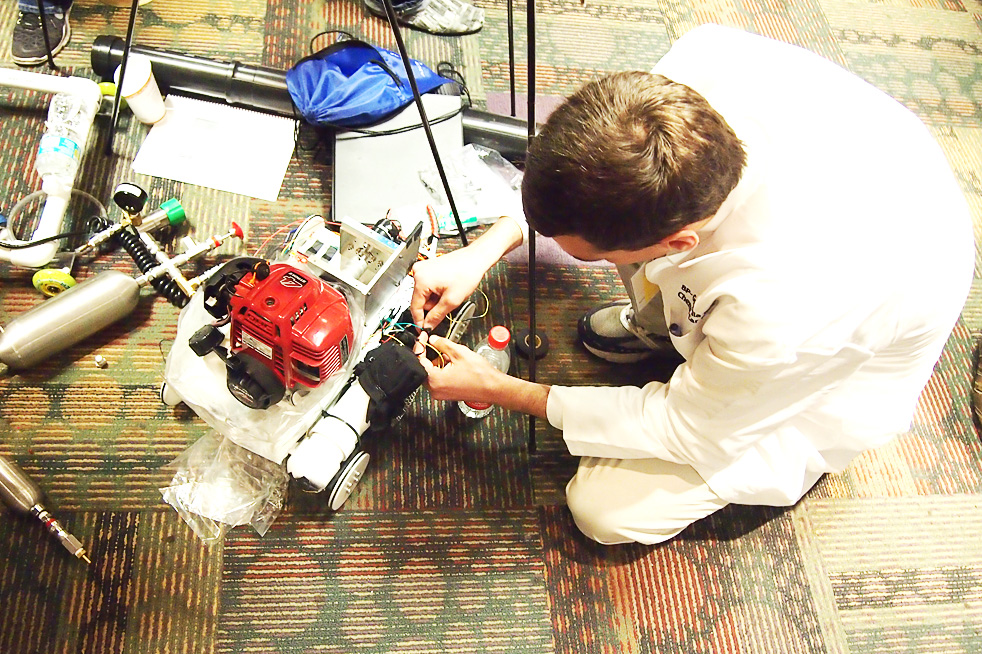One of Tech’s best kept secrets is the ChBE department’s Chem-E Car team. Consisting of Tech undergraduates from ChBE and CHEM departments alike, the team builds a shoebox-sized car powered and stopped by chemical reactions. At annual competitions held by the American Institute of Chemical Engineers, Chem-E Car teams from engineering schools across the nation compete.
The overall goal of the competition is to design a model car that can precisely stop after travelling a precise distance.
To make things interesting, the distance that cars must travel is different at every competition, and competition organizers do not announce the distance of that year’s event until the day of competition. Therefore, teams must be confident that their car’s powering and stopping reactions can be accurately adjusted on the day of competition to allow the car to precisely traverse different distances before stopping.
The Tech Chem-E Car team is fresh off of a sweep of the 2013 regional competition in which they won both first and second place and qualified for a spot at the national tournament this fall.
Keller Smith, a spring 2013 ChBE graduate, was the team’s president from 2011 to 2013. Smith’s role required him to manage many different aspects of the club, and he found himself deeply engaged research and development and administrative duties.
“We start off in the spring semester,” Smith said. “We meet up and discuss design concepts, where we stand on the current cars and what we’d like to change on them.”
After brainstorming, the team must build the car from scratch.
To first-year ChBE major Leon Liu, the experience was educational.
“I loved being a member of the team that really values the freedom to innovate,” Liu said. “Not only was I able to offer my new ideas, but I also gained a lot of knowledge about technologies and processes with which I had no previous experience.”
Liu and the other members of the team tackled projects such as fermenting sugar to produce ethanol for the car’s internal combustion engine and developing a photochromic stopping mechanism.
In the weeks before the competition, the team’s efforts shift from building the car to troubleshooting and calibrating the final model.
“As you get close to the competition, there’s typically a pretty big time crunch,” Smith said. “We’ve had a couple all-nighters before the competition.”
During this process, the team begins running time and distance trials on the car. Through examining the results of these trials, many issues present themselves, one of which concerned the speed of the car as it travelled.
“A big problem was speed consistency,” Smith said.
Smith and the team deduced that given the way their car’s circuitry was designed, they had little control maintaining accurate speeds. Since speed is an important component of distance travelled, this was a major problem.
In order to solve the problem, the team concluded that the addition of a microcontroller that monitored speed data and adjusted power levels accordingly would help solve their problem.
This problem and solution cycle is quite typical of the design process, and it introduced many members of the team to real-life problem solving.
Such a process demands practical skills often overlooked in normal Tech classes, but according to third-year ChBE major Phillip Kisembo, the challenge is worth it.
“Since some of the applied concepts are new,” Kisembo said, “it ends up requiring self-teaching ranging from a chemical process to electrical circuits and even fabrication. It still remains a challenge, but a worthy one.”
The fruits of the team’s labor ripen in early April when regional competition takes place. The team’s success at the 2013 competition didn’t come easily; it was the culmination of many years of design iterations and less successful competition appearances.
Team members find the Chem-E Car experience to be extremely rewarding, especially when the hard work pays off as it did in April 2013.
“I don’t believe we’ve won regionals before,” Smith said, “and to come and take first and second place was a major accomplishment.”
Kisembo enjoyed the role peer-learning played in the team.
“Being part of the team puts you in the best position to learn and apply varying concepts that don’t stop at chemical engineering alone,” Kisembo said.
Liu felt his experiences with the team taught important lessons in teamwork.
“I’ve also learned much about teamwork,” Liu said. “For example, I’ve learned that creativity is at its best when a team builds on each other’s ideas and combs out its kinks.”
Smith believed his years as a team member and president were very rewarding.
“[The best parts are] problem solving and camaraderie with the team,” Smith said.
